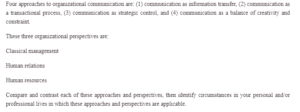Organizational Communication
The four approaches to organizational communication are communication as information transfer, communication as a balance of creativity and constraint, communication as a strategic control, and communication as a transactional process.
The first approach sees communication as the means by which any organization achieves its goals. Thus, for communication to be complete, there must be a clear message, channel, sender, and receiver. If any of these four constituents are ineffective, it will be difficult for the manager to relate with other members of the company. This model also recommends that managers should ensure that the communication process is devoid of ambiguity, distortion, or overload.
The second approach – communication as a transactional process was designed after several criticisms that the first model is incomplete and too basic. This model argues that the sender and receiver of information are one unit and not two distinct entities. Also, it contends that in communication, the meaning or value of a particular information lies in people and not the words sent across.
Thirdly, communication as strategic control asserts that in communication, people/organizations have interests and goals. A good communicator is one who strategically plans to achieve several goals concurrently. Besides, this model canvasses that our environment is regulated by communication. In other words, this model states that communication is complete when people achieve their goals (even when such goals are unethical).
The last model, communication as a balance of creativity and constraint, asserts that there must be a balance in the way employees relate to building or modeling the organization and how constraints are placed to limit their communication. Therefore, this model believes that creativity is an offshoot of the constraint placed by an organization on its employee’s relationships.
Comparatively, these approaches all agree that information is quintessential for organizational success. However, the major difference between communication as an information transfer and communication as a transactional process is that the former focuses on the sender and how the message is sent. In contrast, the latter focuses on the receiver and how the information is interpreted.
Likewise, in the information transfer process, meanings are in words, not people, while in the transactional process, meanings are in people, not words. In addition, the strategic control process encourages people to have interests and goals while relating with other people, but the process balance of creativity and constraint does not encourage such.
On the other hand, the three early perspectives on organizations and communications are the classical management approach, human relations, and human resources. The classical management approach compares the organization to the machines. Just as machines have different parts, an organization has different employees that guarantee its sustenance. If any part of the machine/organization fails or malfunctions, it will affect the entire system.
People heavily criticized the classical management approach for seeing employees as machines. Hence, the human relations approach emerged and argued that humans are the lifeblood of any organization. This model explains that although employees have social and interpersonal needs, they crave to be tied or united with a bigger cause. This model also states that the rapport between employers and employees is essential if an organization wants to achieve its goals.
Conversely, the human resources approach focuses on how an organization can improve employee dialogue and participation. Rensis Likert, Douglas McGregor, and Abraham Maslow are three persons who clearly explained this model in their theories based on the hierarchy of needs, management, and supportive relationships.
Comparatively, these models all agree that employees form an integral part of the company. An organization is an artificial entity operated by natural beings. The organization will fail if it neglects these natural persons who run the company. However, the way employees are viewed through these models is quite different. The first approach sees employees as parts of a machine. In contrast, the other models see employees as people with needs who crave recognition or wish to be included in the decision-making process of the organization.
These approaches and perspectives of organizational communication are important for the decision-making process of any organization. Most companies I have worked with are largely decentralized, meaning that they have a lot of branches, departments, and workforce. Decisionmaking in these organizations is usually difficult, except employees are integrated into the process. Working in an organization where my opinion matters means a lot to me. As a manager in the company where I work, I apply communication as an information transfer and transactional process. I ensure that I regularly inspire people under my care while also ensuring easy access to their complaints. This has helped me tremendously over time.
Reference
Einsberg, E., Godall, H., & Trethewey, A. (2001). Organizational Communication: Balancing
Creativity and Constraint. Boston: Bedford/St. Martin’s
ORDER A PLAGIARISM-FREE PAPER HERE
We’ll write everything from scratch
Question
Four approaches to organizational communication are (1) communication as information transfer, (2) communication as a transactional process, (3) communication as strategic control, and (4) communication as a balance of creativity and constraint.

Organizational Communication
These three organizational perspectives are:
Classical management
Human relations
Human resources
Compare and contrast each of these approaches and perspectives, then identify circumstances in your personal and/or professional lives in which these approaches and perspectives are applicable.


